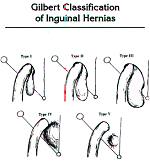About Hernias
![]()
A hernia is an abnormal opening through the muscles of the abdominal wall. Some symptoms include a bulge or lump along with pain.The operation to repair it is called herniorrhaphy or hernioplasty. More than 1.2 million hernias are repaired annually in the United States, yet no two are identical. The outcome of each operation will depend on the patient’s overall health and his or her abdominal wall muscles. The size of the hernia and how long it has been present are other factors. Recurrent hernias can be more difficult to repair, and their outcome can be less predictable than first-time hernias.
![]()
Hernias can form any place in the abdominal wall or flank.
Groin hernias are the most common. They are known as inguinal or femoral, depending on their location. Both occur through openings in the wall of the lower abdomen, the same openings through which large blood vessels and nerves go to each thigh. Groin hernias account for almost 80 percent of abdominal wall hernias. Some are present in the lower abdomen; others protrude downward into the scrotum. While hernias are more common in men, hernias also occur in women. A variety of hernias make up the remaining 20 percent.
- Umbilical hernias occur through the navel.
- Incisional hernias are found in sites of previous operations.
- Aponeurotic hernias occur in the midline, usually above the navel.
- Spigelian hernias are found along the outside of the large muscles that run from the rib cage down to the pelvis.
For more information about the different types of Hernias, click here.
![]()
Almost all hernias of the groin result from years of progressive weakening of the tissues or from birth defects (congenital).
Activities associated with the presentation of hernias include:
- Unusual exertion in lifting, pulling or pushing
- Coughing attacks
- Straining during a bowel movement or trying to urinate
- Significant weight gain or loss
The appearance of a hernia may be sudden or gradual. Some are preceded by annoying burning pain, others by mild discomfort around the affected area.
Many occur without pain; only a bulge is noted. The bulge represents internal organs (intestine, omentum or bladder) which have protruded through the opening in the abdominal wall. Most hernias protrude when the person stands or sits. Typically, a bulging hernia flattens (reduces) when the person lies down; it then protrudes again when he/she is upright. When a hernia cannot be reduced, it is called irreducible or incarcerated. When an internal organ of an incarcerated hernia cannot be reduced, its blood supply can be compromised causing it to become strangulated. This extremely serious consequence is usually preceded by feeling a tender lump that will not reduce. Strangulation is a critical surgical emergency. If you think your hernia is strangulated, don’t delay. Get medical help immediately! Click here to learn more about hernia causes.
Comments are Closed on this Post